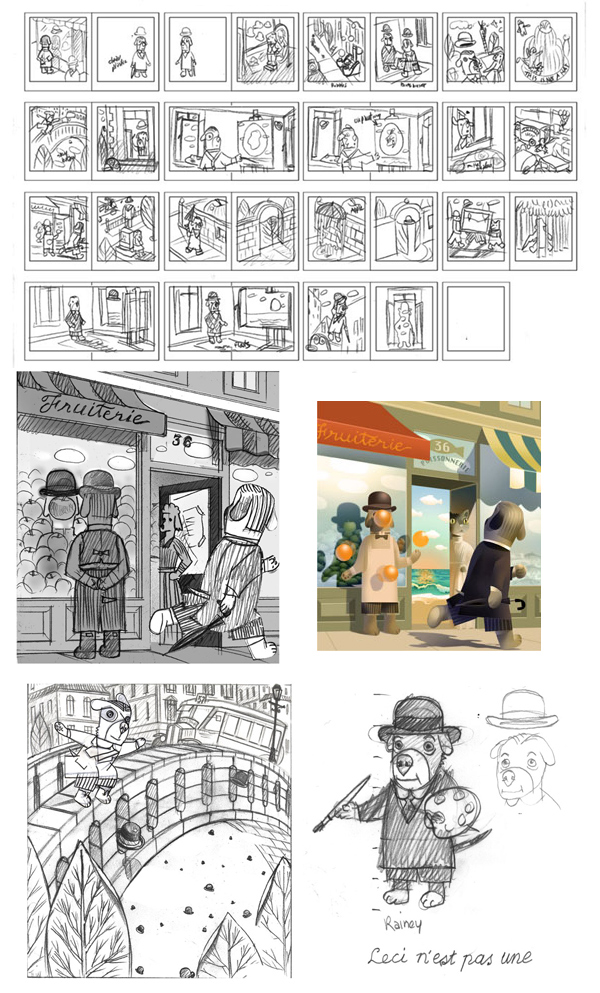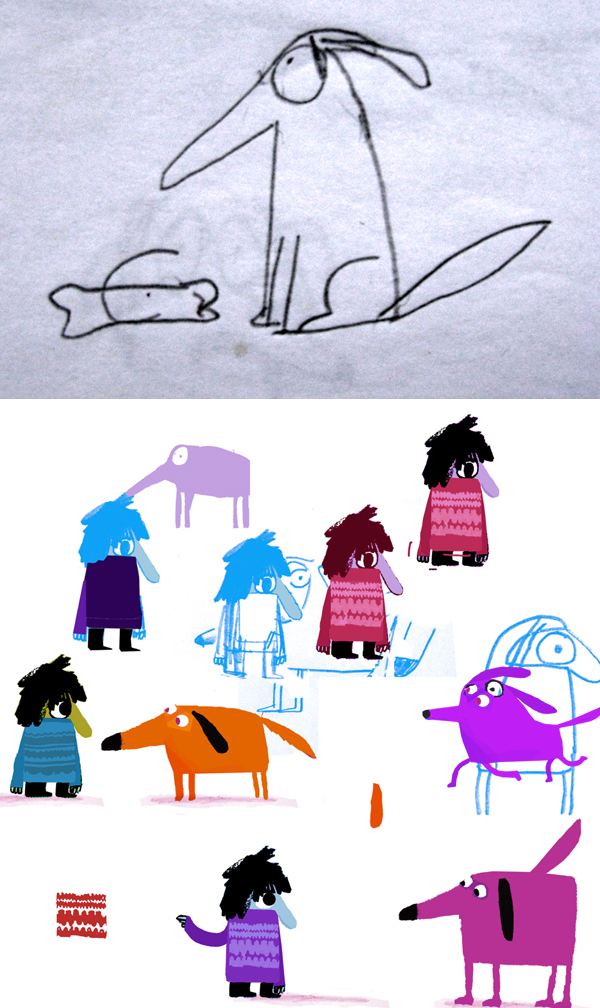Archive for April, 2012
Tyler Makes Pancakes
Written by Tyler Florence | Illustrated by Craig Frazier | Harper Collins 2012

Foodie and friend Tyler Florence and I have cooked up a book together, Tyler Makes Pancakes! Meet little Tyler and his slightly chubby canine pal, Tofu. Awakened from a vivid dream in culinary outer space, Tyler is inspired to whip up some pancakes before his parents have their first cup of joe. With Tofu in tow and the help of a patient local grocer, Tyler learns all the places that his necessary ingredients come from. He visits a chicken ranch in California, harvests wheat in the fields of Kansas, picks blueberries in Maine and makes syrup in frigid Vermont. The take home lesson—good food isn’t grown on shelves.
This is how it happened. I met Tyler at the gym and said in passing one morning that we should try to do a kid’s book together. In his trademark southern enthusiasm, he said let’s get to it!
Tyler suggested this little guy that is obsessed with food, has food dreams and wants to learn to cook. Hmmm, sounds familiar. Well, I did some sketches and little Tyler was born. We designed ‘little Tyler’ as a round-headed, little bodied dude with curiosity written all over his simple face. Though I worked on ‘developing’ both characters, it turns out I didn’t stray far from my initial sketches.
We got together over several cups of coffee and Tyler started telling a story, and we both sketched at the same time. Tyler gets ridiculously excited about food and wants kids to as well. He’s waving his hands telling the story like it’s a movie and I’m trying to pack it into 36 pages! I drew up a storyboard that we knocked around until we thought we had shaped a good story. Then he got to the words and I got to the illustrations. It’s that simple—only took 2 years!


Tyler and Craig launch the book at his Mill Valley store to a packed house of young chefs.
Magritte’s Marvelous Hat
By D.B. Johnson | Houghton Mifflin Harcourt 2012

D.B. Johnson has performed a magical feat—he has created a book that celebrates the wondrously surreal artist and work of René Magritte. Magritte’s Marvelous Hat is a tour de force by any measure of a contemporary picture book making. Not only is it a homage to one of the most famous artists, it is a magical story that is illuminated by truly transporting illustrations—not to mention the inventive use of transparent overlays. If you like DB, Magritte, illusion, floating fruit, Paris, exquisite book production, or dogs— you must have this book. Mine is levitating of my table at the moment.
D.B. was kind enough to submit to an interview and send along some of his beautiful sketches. Thanks D.B.!
cf The book looks deceptively complex—at what point did you decide to employ the transparent overlays?
db I loved how simply, almost magically, a page turn could transform the images. And if the page were transparent, it seemed as if the change were happening in real time (or surreal time anyway). I suppose I was thinking that in some weird sense people might accept a surreal image like an apple floating in front of someone’s face (a Magritte icon) if they saw it happen before their eyes—weird because I was already asking them to believe in a dog dressed like a man who painted pictures in 1920s Paris.
At the time I didn’t know whether it was even feasible to print on transparent pages in a children’s book or, if it was, would my publisher be willing to do it? I kept asking myself, does it add something worthwhile? But I soon realized that the overlays opened up a lot of story and image possibilities. For example, in the opening spread when Magritte looks in the store window and sees the hat, his reflection is all wrong—we see the back of his head instead of his face reflected in the glass (this of course is my riff on another well-known Magritte painting). A normal page turn might have sent the reader to a new spread of pictures without even noticing.
I think it’s easy to be charmed by the transparent page turns, but in the last analysis I think it’s the story that resonates. I spent a year trying to get just the right combination of story engagement and picture wonderment to satisfy a child.
cf Have you always been a Magritte fan?
db The paintings of René Magritte had always been a rich source of ideas for me during my 25 years as a freelance illustrator, and I’m certain I was not alone. I still see ideas everywhere in advertising and editorial art that are inspired by Magritte. For me, placing ordinary objects in impossible contexts is a powerful idea generator and a direct link to the imagination. Each picture in this book is my personal riff on one or more of Magritte’s paintings, that is, the art is entirely mine, but the process of creating it came from the spark of Magritte’s genius. I hope the reality bending images in Magritte’s Marvelous Hat will start kids on the road to imaginative thinking of their own.
cf How long did this book take you to complete?
db I produced dummies for three completely different versions (including an Inspector Magritte story) with handmade overlay pages, before my book became Magritte’s Marvelous Hat. Then I spent another year doing the final art and getting all the overlays to work. I’m incredibly lucky to have a very patient and insightful editor, Margaret Raymo, and a publisher willing to take on a project like this.
cf Are your illustrations created with traditional airbrush?
db I abandoned the toxic world of traditional airbrush for its digital equivalent. It looks the same, but it’s better for me and the environment.
cf Was it as fun to draw as it is to look at?
db I always love the drawing part of creating books which is a good thing since I typically spend a year doing the art. Once I’ve written and sold my story I break the text into spreads and draw thumbnails. I spend a lot of time creating the character—in this case, I was thinking of that Paul Simon song “René and Georgette Magritte With Their Dog After the War” and decided Magritte would be a dog. I even found a picture of the couple with a small dog. My dog’s final look was based on Magritte’s broad, jowly face (animal caricature has long been a staple of my work). Because I’m rendering in airbrush, there’s not a lot of improvisation once I start the final art—so my pencil sketches are worked until I’m completely satisfied with the image and the design before I begin.
cf What’s your process like?
db I’m always working to unify the images and the text. Though I know the story is in the driver’s seat, I do make changes in the text as I work on the art. For example, I love the Magritte painting The Dominion of Light which depicts a house and street in darkness with the sky in bright daylight—so naturally, when Magritte in my story forgets all about his hat and paints all the time, I write that he “begins to paint day and night” and I intend it both figuratively in the text and literally in the picture. In this case the art dictated the precise language of the text.
It wasn’t until I started drawing the picture of a discouraged Magritte sitting at the base of a statue in the park waiting for his hat to come back that I decided to add a little piece of text to the image by inscribing the monument “B. 1967 D.1898”: the dates in reverse order of René Magritte’s life. I think he would have enjoyed that!

Oh No, George!
Chris Haughton | Candlewick Press 2012

Author of Little Owl Lost, Chris Haughton has published a new book about the travails of an undisciplined hound called Oh No, George! The story is simple—if left alone will a dog do as he says and be good? We know he won’t but we are drawn into the subconscious of George as he struggles with his own canine demons. Many of us say to our dogs, “be good” when we close the door, knowing they are just going to sleep. George does everything you fret except get into the liquor cabinet—but that’s another book. Against his own will, he devours the cake, the cat, and unearths the flowerbed. The fun in this book is Chris’ graphic and expressive style of drawing and coloring with his festive (Mexican) palette and super graphic scale. George is a bad dog, but not without redemption as told in the second half of the book.
The trailer is as cute as the book:
Thanks you Chris for sharing a few of your early sketches in making this devilish hound and strange owner.

















